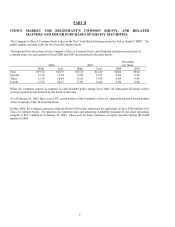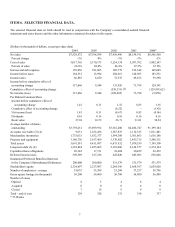Dillard's 2004 Annual Report Download - page 20
Download and view the complete annual report
Please find page 20 of the 2004 Dillard's annual report below. You can navigate through the pages in the report by either clicking on the pages listed below, or by using the keyword search tool below to find specific information within the annual report.
Cost of sales as a percentage of sales increased to 68.0% during 2003 compared with 66.4% for 2002. The decline of
160 basis points in gross margin during fiscal 2003 was due to competitive pressures in the Company’s retail sector and
the resulting effort to maintain a competitive position with increased markdown activity. The higher level of markdown
activity increased cost of sales by 3.7% of sales. Improved levels of markups partially offset this promotional activity
during fiscal 2003. The increased markup percentage was responsible for a decrease in cost of sales of 2.1% of sales. All
product categories had decreased gross margins during 2003 except cosmetics, which increased 10 basis points from
2002.
Expenses
2004 Compared to 2003
Advertising, selling, administrative and general (“SG&A”) expenses increased to 27.9% of sales for fiscal 2004
compared to 27.6% for fiscal 2003. On a dollar basis, SG&A expenses were up slightly over the prior year. SG&A
expenses in fiscal 2003 include a $12.3 million pretax credit recorded due to the resolution of certain liabilities originally
recorded in conjunction with the purchase of Mercantile Stores Company, Inc. that were deemed not necessary based
upon current information. For fiscal 2004, savings in bad debts of $25.9 million (as a result of the sale of the Company’s
credit card business in November 2004 and decreased bad debt write-offs throughout the year), services purchased of
$11.3 million and communications of $4.0 million were offset by increases in incentive payroll of $8.6 million,
insurance of $8.6 million and advertising of $16.9 million. The reduction in services purchased and communications
was partially due to the sale of the credit card business in November 2004 and costs reductions throughout the year.
Services purchased includes marketing, collection fees and merchandise handling costs. Communications includes
telephone, postage and data line expenses. As a result of the Company’s improved performance, incentive compensation
to store managers, merchants and management significantly increased during the year ended January 29, 2005. Also
during the year, Dillard’s increased its provision for workers’ compensation self-insurance to reflect an expected increase
in future medical costs. Dillard’s increased its advertising expenditures during the year as it continued to evaluate new
media outlets better suited to meet its customers’ lifestyles than those outlets traditionally employed. Due to the sale of
the credit card business, bad debt expense will be non-recurring in fiscal 2005.
Depreciation and amortization as a percentage of sales increased to 4.0% for fiscal 2004 compared to 3.8% for fiscal
2003. This increase is due to higher capital expenditures in 2004 and the addition of capital leases for data processing
equipment in 2004 which have shorter useful lives.
Rental expenses experienced a decline due to a lower number of leased stores in fiscal 2004 compared to the prior year
and lower data processing equipment rent. Leased stores declined from 71 stores at January 31, 2004 to 65 stores at
January 29, 2005 resulting in lower rent expense of $6.6 million. Lower data processing equipment rent of $2.7 million
was due to a certain number of 2004 leases qualifying for capital lease treatment. A review of the Company’s lease
accounting policies resulted in a charge of $821,000 for straight-line rent during fiscal 2004.
Interest and debt expense as a percentage of sales decreased to 1.8% for fiscal 2004 compared to 2.4% for fiscal 2003
primarily as a result of lower debt levels. Interest expense declined $42.0 million in fiscal 2004. Average debt
outstanding declined approximately $602 million in fiscal 2004. The debt reduction was due primarily to the assumption
by GE of $400 million in accounts receivable securitization debt and the payoff of seasonal borrowings in conjunction
with the sale of the Company’s private label credit card business to GE. The Company also redeemed the $331.6 million
Preferred Securities and had maturities of outstanding notes of $163.4 million during fiscal 2004. Interest expense for
fiscal 2003 includes a credit of $4.1 million received from the Internal Revenue Service as a result of the Company’s
filing of an interest netting claim related to previously settled tax years. A call premium of $15.6 million related to the
early retirement of debt is also included in interest expense for fiscal 2003.
During fiscal 2004, the Company recorded a pre tax charge of $19.4 million for asset impairment and store closing costs.
The charge includes a write down to fair value for certain under-performing properties. The charge consists of a write
down for a joint venture in the amount of $7.6 million, a write down of goodwill on one store to be closed of $1.2
million, an accrual for future rent, property tax and utility payments on three stores to be closed of $3.1 million and a
write down of property and equipment in the amount of $7.5 million. The Company does not expect to incur significant
16
























